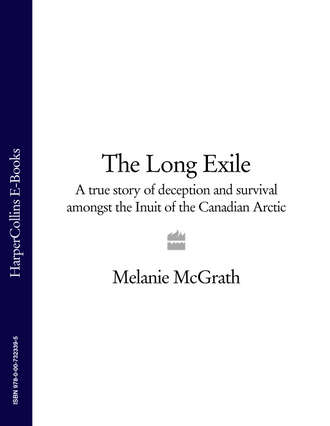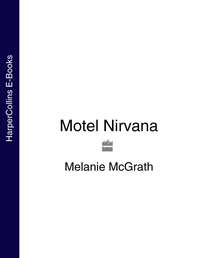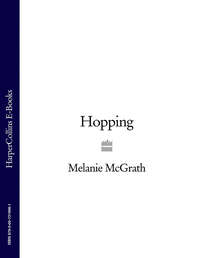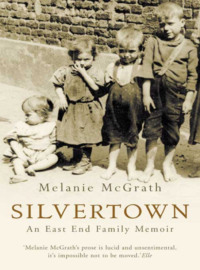
Полная версия
The Long Exile: A true story of deception and survival amongst the Inuit of the Canadian Arctic


MELANIE McGRATH
The Long Exile
A True Story of Deception and Survival in the Canadian Arctic

‘An Eskimo lives with menace, it is always ahead of him, over the next white ridge.’
ROBERT FLAHERTY
Table of Contents
Preface
Chapter 1
Chapter 2
Chapter 3
Chapter 4
Chapter 5
Chapter 6
Chapter 7
Chapter 8
Chapter 9
Chapter 10
Chapter 11
Chapter 12
Chapter 13
Chapter 14
Chapter 15
Chapter 16
Chapter 17
Chapter 18
Chapter 19
Chapter 20
Epilogue
Selected Bibliography
Acknowledgements
About the Author
Praise
Copyright
About the Publisher


PREFACE
There have been many books written about the Arctic, mostly tales of explorers and derring-do. This book isn't one of those. It is rather the story of a movie and the legacy left behind by its maker. The film is Nanook of the North, which has been described by filmmakers as diverse as Orson Welles and John Huston as one of the greatest pictures ever made. Its Irish-American director, Robert Flaherty, arrived in the small settlement of Inukjuak on the east coast of the Hudson Bay in 1920 to make it. He filmed it in a year, but was haunted by it for the rest of his life. The movie's success helped colour the western view of Inuit life in the Arctic for generations. It does so today. Flaherty never returned to the Arctic, but he left a son there, who grew up Inuit. More than thirty years later, a group of Inuit men and women were removed from Inukjuak by the Canadian government and taken hundreds of miles north to the uninhabited High Arctic. Among them was Robert Flaherty's son. This book is as much about Josephie Flaherty and his family as it is about his father's movie.
It is often said that the Inuit have dozens of words for snow. While this is true it doesn't tell the whole story. The Inuit do have many words to describe snow, but they also differentiate between various kinds of snow those of us who don't live in the Arctic would see as being essentially the same. It's not so much that the Inuit have dozens of words for snow, as that, in the Inuit world, there are dozens of different kinds of snow.
There are also emotional differences in the way Westerners and Inuit view the world. Until very recently, emotions like envy or sexual possessiveness were so perilous to the equilibrium of the Inuit – living as they did in family groups, often separated from each other by thousands of square miles of ice and tundra – that they were vigorously discouraged. There was a time when expressing rage, lust or ambition was considered so threatening to the group's survival that persistent offenders were ostracised from the community and sent to their deaths on the tundra; some persistent offenders were even killed outright, often by their own families. For thousands of years, these threatening emotional traits were suppressed to such a degree that they were rarely felt among the majority. Other, more helpful traits crept in to take their place: modesty, patience, acceptance of group decisions and a sense of being not just bound to the group, but being an integral part of it, a vital organ in the family body. These are more common and more valued character traits among Inuit even today than they are among people living in large cities in the West.
Although it regularly occurs, we are not necessarily aware of a similar process of emotional editing taking place in our own lives. It's not hard to recall feelings those of us living urban lives have allowed to wither: a wonder and respect for nature, a feeling of being at one with the land, an inexorable identification with home and family, a sense of belonging. We may regret the passing of these feelings; indeed, if our appetites for nostalgia are anything to go by, we certainly do, but few of us would want to go back and live as our great-great grandfathers and grandmothers lived; nor must we in order to feel respect, even awe, for what our ancestors endured and the kind of people they were.
It is easy to feel disconnected from human beings to whom we are neither related by blood nor fate and with whom we share few cultural connections; people whose range of emotional expression and personalities may feel very different from our own or from anyone we know.
And so, when you read this story, bear this in mind; however many kinds of snow there are and however many words for them, they all, in the end, melt down to water.
1
In the early autumn of 1920, Maggie Nujarluktuk became a woman with another name. It happened something like this. Maggie was sitting on a pile of caribou skins. She had a borrowed baby in her amiut, the fur hood of her parka. A man was filming the scene. His name was Robert Flaherty. Maggie was about to pull the baby out of the amiut and set him to play beside a group of puppies as Flaherty had instructed, when looking up from his camera, he said, ‘Smile’, grinning to show Maggie what he was getting at and told her, through an interpreter, that he had decided to change her name. She laughed a little, perhaps conscious of his eyes, blue as icebergs, then lifted the baby into her arms, placed him beside her and pulled the puppies closer to keep him warm.
‘Well, now, Maggie,’ Robert said. He winked at her, wound the camera and lingered on her face. She watched his breath pluming in the chill Arctic air.
‘How's about Nyla?’ He allowed the name to roll around his mouth. ‘Yes, from now on you are Nyla.’
If Maggie minded this, she didn't say. She already knew she has no choice in the matter anyway.
Maggie Nujarluktuk was very young back then (how young she didn't know exactly), and very lovely, with a broad, heart-shaped face, unblemished by sunburn or frostbite or by the whiskery tattoos still common among Ungava Inuit women. Her thick hair lay in lush coils around her shoulders and her skin and eyes were as yet unclouded by years of lamp smoke or by endless sewing in poor light. Her lips were bowed, plump but fragile-seeming, and it was impossible to tell whether her smile was an invitation or a warning. Beneath the lips lay even teeth that were white and strong, not yet worn to brown stumps from chewing boots to make them soft. And Robert Flaherty had just renamed her Nyla, which means the Smiling One.
Robert Flaherty's movie had begun in something of a rush. Only three weeks earlier, on 15 August, the schooner, Annie, had dropped anchor at the remote Arctic fur post of Inukjuak, on the Ungava Peninsula on the east coast of Hudson Bay, and a tall, white man with a thin nose and craggy features had come ashore with his half-breed interpreter, introduced himself to the local Inuit as Robert Flaherty, and announced his intention to stay in the area long enough to make a motion picture there. The film, he said, was to be about daily life in the Barrenlands.
The stranger moved into the fur post manager's old cabin, a peeling white clapboard building on the south bank of the Innuksuak River and hired a few hands to help him shift his things from the shoreline where the Annie's crew had left them. Among the expected baggage of coal-oil lamps, tents and skins were the unfamiliar accoutrements of film-making, lights, tripods, cameras and film cans, plus a few personal belongings: a violin and a wind-up gramophone with a set of wax discs and three framed pictures, one a photograph of Arnold Bennett, another of Flaherty's wife, Frances, the third a little reproduction of Frans Hals' Young Man with a Mandolin. The number of possessions suggested that Robert Flaherty was settling down for a long stay. Within a day or two of his arrival, he had hung his pictures above the desk in his cabin, lined up his books along a home-made shelf, rigged up a darkroom, setting several old coal-oil barrels outside the door to serve as water tanks for washing film, and found three young men he could pay to haul his water and supply him with fresh meat and fish. By the time a week was up, the cabin looked as though it had always been his home and Flaherty was busy assembling his lights and cameras and running tests. In the evenings, he could be heard humming along with his gramophone (he was particularly fond of Harry Lauder singing ‘Stop Your Ticklin' Jock’) or playing Irish jigs on his fiddle.
The local Inuit were not much used to white visitors, and the new arrival turned the little settlement of Inukjuak upside down. No one knew quite how to place Robert Flaherty. His particular brand of whirlwind energy was new to them. Nor had they ever come across a qalunaat, a white man, with such sturdy warmth and rushing good humour. The fur traders they had encountered were glum and troubled and fond friends of the whisky bottle. News of the stranger spread, and the Inukjuamiut, as the people living around Inukjuak are called, began coming in from outlying camps to inspect this new addition to their world. Flaherty greeted them all with smiles and gifts of ship's biscuits and this, too, felt out of the ordinary. A few wondered, darkly, what the strange qalunaat wanted from them and drifted back out to their camps, but more stayed on, intrigued by the stranger and eager to audition for a part in the movie he said he was about to make.
Flaherty was soon holding try-outs on the river bank in front of the fur post manager's cabin. To play his leading man he picked a strong, good-natured fellow in his thirties called Alakariallak, who was renowned throughout Cape Dufferin for his hunting prowess. Flaherty renamed him Nanook, meaning ‘bear’. To play one of Nanook's wives Flaherty chose a local woman called Cunayou, to play the other, Maggie Nujarluktuk.
This was not Robert Flaherty's first attempt at making an Arctic film, but it was almost certainly his last chance to get it right. A few years later, when he had become famous, a journalist asked him why he had persisted back then, after so many setbacks and difficulties, and he replied, as he often did, with an aphorism, saying that ‘every man is strong enough for the work on which his life depends’. In 1920 Robert Flaherty believed his life depended on this movie. And, as it turned out, he was right.
Flaherty had first pitched up in the Canadian Arctic ten years previously, looking for iron ore, in the employ of Sir William Mackenzie, a Canadian mine owner and railroad baron whom Flaherty had met through his father. Mackenzie had invested considerable capital in a transcontinental railway across Canada and he was planning to lay track as far north as Churchill, Manitoba, a bleak Barrenlands settlement on the west coast of Hudson Bay. Mackenzie's goal was to link the railway with a new shipping route across the bay and thereby create the shortest navigation between the wheat plains of Manitoba and the flour mills of Europe, which were then connected overland and by sea through the St Lawrence River to the Atlantic. There were additional benefits, which Mackenzie, being a good businessman, had not ignored. It was well known that Hudson Bay's seabed was rich in iron ore – for centuries whalers had reported compass interference whenever they sailed there – and some enormous iron ore lodes had been discovered on the east coast of the Bay in the Ungava Peninsula just north of Labrador. Mackenzie reckoned there might be money to be made extracting the ore and shipping it to Europe.
His geologic interest focused on the Nastapoka Islands, a cluster of granite nubs lying just off the east coast of Hudson Bay at 57° North. The Nastapokas had figured in some prospectors' logs as being worthy of exploration. Inuit had been living in the area for thousands of years but the place was only scantily mapped and virtually unknown to white men. Mackenzie needed someone young and ambitious with courage and flare, even a little recklessness, to blaze a route through. In 1910 he chose Robert Flaherty. The railroad baron had employed Flaherty's father, Robert Flaherty Snr, and knew the family from the old days, when the American frontier was still open and the Flaherty family had helped to settle it. At 26, Robert Jnr already had a reputation for adventurous prospecting in the northern forests of Canada and although he had had no direct experience of the Barrenlands, Mackenzie felt inclined to take the risk on him.
The Flahertys had come over from Ireland sometime during or just after the potato famine and, travelling south from Quebec, they had settled in the tough mining country of Michigan. There Robert Jnr's father, Robert Henry Flaherty, had met and married Susan Klöckner, the daughter of Catholics from Koblenz. Robert Henry had done well for himself, buying up a modest little mine at the foot of Iron Mountain, Michigan, where Robert Joseph was born, on 16 February 1884, the first of seven children.
The family lived a comfortable upper-middle-class life. Robert Jnr grew up with a love for the outdoors and a disdain for civilisation which was remarkable even among boys living in the wilds of Michigan. This untroubled existence came to a sudden end, though, in 1893, when the price of iron ore slumped and Robert Snr was forced to lock out the miners at his Iron Mountain operation and later, when things did not improve, to close the mine down altogether. Of necessity, he took up a position as a mining engineer in the tiny backwater of Lake of the Woods in upper Ontario, leaving his wife to bring up their children alone.
Susan Klöckner was a loving, devout and uneducated woman and she did her best to raise Robert Joseph in the fear of God, but none of her sermonising appeared to have the slightest effect on her eldest son. If there was a god in Robert Flaherty's life he was to be found in the woods with the bears.
So the boy grew up wild, and when Robert Henry returned to Michigan his son begged to go with him on his next posting to a remote outpost, the Golden Star Mine in Rainy Lake, Ontario. It was a Huckleberry Finn kind of a life and Robert Jnr took to it like a trout to tickling. For two years father and son camped out in the woods, hunting rabbits, tracking bear and learning woodcraft from the local Ojibwa Indians. During the long winter nights, the boy lost himself in the adventure stories of James Fenimore Cooper and R. M. Ballantyne and in the long summer evenings Robert Snr taught his son to play the Irish fiddle. Robert Jnr learned some sharper lessons from the Ojibwa too. Years before, miners and fur trappers had brought booze and misery into the lives of the Indians living in northern Ontario. The sight of strong, capable men staggering around begging moonshine off the miners crept across the young Robert's tender heart like a shadow. If this was what men called civilisation, then he wanted no part of it.
When Robert Snr's two years in Rainy Lake were up, the Flaherty family moved on again, to the Burleigh Mine back near Lake of the Woods. Deciding their son needed some formal education, Susan and Robert Henry dispatched Robert Jnr to Upper Canada College in Toronto. The college was run with the rigid discipline of an English public school. It was intended to whip the boy into shape, but only made a square hole for a round peg. Robert Jnr soon contrived to get himself expelled, returning to Port Arthur (now Thunder Bay) on Lake Superior, where the Flaherty family were then living and enrolling in the local school. Even there Robert Jnr chafed against any kind of formal instruction, preferring instead to spend most of his time with the English mining engineer and adventurer, H. E. Knobel, who encouraged the boy's fiddle playing as well as his fantasies.
It was through Knobel that Flaherty first heard tell of Hudson Bay, a remote seaway bitten out of the eastern Canadian mainland. Knobel had been canoeing there and had stories to tell of the rapids he had paddled, the portages he had passed and the Indians and Inuit he had met on the way. The young Robert was so taken with Knobel's stories of adventure in remote places that, after a final and brief flirtation with book learning at Michigan College of Mines, he gave up formal education altogether and went north, into the woods to prospect for ore, hoping, one day, to travel as far as Hudson Bay. When, in 1910, Sir William Mackenzie asked him to lead an expedition to the Nastapokas, Robert Jnr felt his destiny calling. He did not hesitate.
Taking his tent, his rockhound kit, canoes and an Indian guide, the 26-year-old Flaherty paddled along the Mattagami River north, across some of Canada's toughest portages, then followed the Moose River as far as the Hudson Bay trading post at Moose Factory in James Bay, a broad finger off the southernmost curve of Hudson Bay. At the factory, he stopped briefly to resupply, then took a boat to Chariton Island and hitched a ride on a schooner going north to Fort George. There he came upon an encampment of Inuit who guided him to the Hudson Bay post at Great Whale, otherwise known as Kuujjuarapik, a tiny settlement on the tree line, at the edge of the Barrenlands.
Flaherty was used to wilderness, but no wilderness he had ever experienced matched this. The Barrenlands made the deep, silent forests and rugged hills of his childhood seem as safe as apple orchards. He felt the flinty, lichen-painted sweep of the tundra and the great expanses of sea and ice and sky as a swelling in his chest. The starkness of the place enthralled him. It was as though every step further north was a footfall on a new discovery. The tundra rolled out, empty and uncompromised, all around him. If any land could be said to be the antidote to the diseased, corrupted, famine-ridden Ireland of his ancestors, it was here, where there were none of the tired overlays of human history, only the shallow sun and the shadows of low clouds chasing along the rock. Nowhere, not even in northern Ontario, had Flaherty felt more free.
He took on some Inuit guides at Kuujjuarapik and was soon as captivated by them as he had been by their land. These men understood the Barrens in a way Flaherty had never understood Michigan or lower Canada. Only now, in all this emptiness, did he begin fully to comprehend the fullness around him. He watched these men pull their living from it. He saw them moving over the fearsome weft of ice and stone as if it were a carpet and across the sea as if it were a lawn. He had grown up a witness to the demoralisation of the Indians who lived to the south. But these Barrenlanders were different. They still seemed in possession of a raw, unquestioning confidence, a strong, visceral simplicity which had long been lost at the tree line and, further south, in the hubbub of the cities. This huge, open terrain lived in them. You could not separate them from the environment, as the Indians had been separated from theirs. Without the Barrens, they would cease to exist. It dawned on Flaherty that he was witnessing something unique and precious, a window into an older and, perhaps, a better world.
The Inuit were not the first people to visit the Arctic. That accolade belongs to the Indians. As early as 5500 BCE, Indians had been moving from the forest on to the tundra in summer, following the migration routes of caribou, and they continued to move seasonally on to the Barrenlands for the next 2,000 or 3,000 years, until a change in the climate drove them back down south. It was not until some time between 3000 BCE and 2200 BCE that the Inuit crossed the Bering Strait, which was then a land bridge, into what is now North America, and spread eastwards until, by 1000 BCE, they had reached Labrador. The Inuit were the first people to occupy the Arctic permanently and they brought with them two technologies essential to their survival there, the bow and arrow and the kayak. From time to time they encountered Indians and when they did there were skirmishes, but for the most part they lived, untroubled, for 2,000 years or more until around 1000 AD when they had contact first with Vikings then with European adventurers, the best known of whom was Martin Frobisher, who arrived on Baffin Island in 1576 looking for gold. By the seventeenth century whaling ships from Scotland and North America were making regular forays into Arctic waters and overwintering in Hudson Bay. There they set up whaling camps to which the Inuit were drawn by the promise of paid work and by metal knives and, later, by rifles.
The Inuit were friendly towards Robert Flaherty, perhaps because they sensed his admiration for them. He was genial and gave off an air of integrity without ever being stiff or formal. Unlike most qalunaat he seemed genuinely keen to learn Inuktitut and the Inuit at Kuujjuarapik quickly got the sense that he saw them as equals and understood that, in the Barrenlands, it was they and not white men who were kings. His good manners, amiability and his fiddle-playing all helped endear him to them, as did his willingness to pay for the guiding and hunting they did for him. In the long history of contact between whites and Inuit, he was, they could see, someone quite rare. White men like Flaherty were hard to find in Inuit country.
From Kuujjuarapik, Flaherty continued north, and, after four months of travelling, he finally reached the Nastapoka Islands in January 1911. He and his guides set up camp and he began immediately to explore, digging through the hard-packed snow for rock samples and documenting everything he saw with photographs. He also took pictures of the men and women he encountered along the way. In their company, he began to feel both recognised and exposed. Their resilience, their competence and their good humour touched him. More than that, he felt drawn to their wildness and after only a few days in the Nastapokas he began to sense his destiny lay not in the rock but in these people and the way they made him feel.
After returning to Toronto to report his findings, Flaherty almost immediately found an excuse to go back up north. This time his aim was the Belcher Islands, an obscure cluster of rocks off the coast of Cape Dufferin, just south of the Nastapokas. The cape occupied an area the size of England and had a population of 200 Inuit, some of whom hunted walrus out on the Belchers. On the Nastapoka trip he had been told of the existence of a large island in the Belcher group whose tall blue cliffs bled when scraped and this suggested to Flaherty the presence of high-grade iron ore there. The island did not appear on any of the maps and there was no mention of it in any navigation charts, but Flaherty had witnessed the precision with which the Barrenlanders memorised their landscape and were able to recall its contours. He decided not to believe the maps but to put his trust in the Inuit instead.
The following year, he set out in the 63-foot sloop, Nastapoka, but was forced back to Kuujjuarapik by bad weather. Running low on supplies, he sailed south to Fort George to restock and when the sea froze over some months later he took off once again, this time by dog sled, intending to cross the Ungava Peninsula to Cape Dufferin, then complete the remainder of the journey to the Belchers on the sea ice. That far north, he figured, the ice would be stable. He was wrong. The ice proved so turbulent that year that Flaherty had to abandon his original plan. Instead, he decided to cross the Ungava Peninsula and try to reach Fort Chimo, or Kuujuak, on the eastern side. It was a crazy plan. Ungava was an unmapped, treeless tundra the size of Norway. No white man had yet crossed it from one side to the other, partly because travelling in the interior was exceedingly dangerous. Away from the coast, the only available food, aside from the odd Arctic hare, lemming or fox, was caribou and the caribou populations had been radically reduced since the introduction of rifles to the region. The adventurer Albert Peter Low had recently been forced to turn back from the Ungava interior to the coast on the point of starvation and Flaherty had none of Low's experience.








